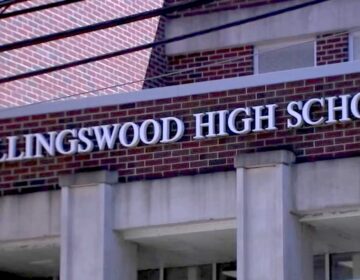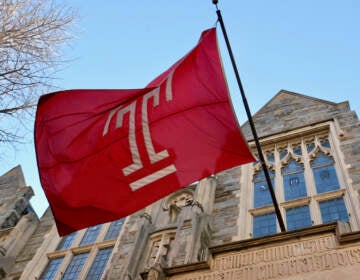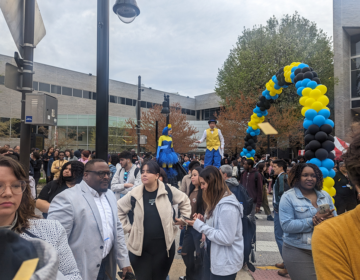Smooth sailing now, but choppy waters ahead for Philly school budget

Philadelphia schools Chief Financial Officer Uri Monson. (Emma Lee/WHYY)
Despite the expectation of a small balance of $33 million in the next fiscal year, the Philadelphia School District’s financial picture remains bleak, with expenditures far outpacing revenues and an anticipated shortfall of nearly a billion dollars by 2022.
That was the message from Chief Financial Officer Uri Monson as he presented the annual “lump sum” budget to the School Reform Commission Thursday, along with five-year projections that lay out in detail how that cushion quickly curdles into a $138 million “negative fund balance” by 2019, just one year later.
“We’re actually exactly where we were a year ago, we’re just a year closer to that problem and our goal is for all of our funders to understand that and help us find ways to work to fill those gaps in the future,” said Monson. “The time is running out for that future.”
The projections are based on current revenue sources and recent trends in funding from the state and city, on which the district relies for most of its revenue.
They also factor in $150 million in additional compensation costs over five years for teachers, who have worked without a contract and received no raises since 2013 as the district and teachers union continue their protracted stalemate over wages, benefits and work rules.
School closings sought
The five-year plan also discloses the intent of Superintendent William Hite to recommend closing three schools a year starting in 2019 due to declining enrollment, resuming a divisive and controversial policy in response to continued student migration to charter schools.
While such closures don’t show immediate fiscal benefits, they eventually reduce costs and are necessary in the long run to ensure efficiency, Monson said.
“Our point is that, from a fiscal point of view, when enrollment declines happen, it is not cost-effective to operate certain schools,” he said.
Even accounting for those savings, the district expects costs to rise at about twice the rate of revenues between fiscal year 2017 to fiscal year 2022.
Despite that dire picture, Monson said the district does not plan to ask City Council for additional funding when officials make their annual appearance in May. The intent is to present the district as a “responsible fiscal steward” doing its best to educate the city’s children in district schools and charters with the money available to it, while not sugarcoating what is coming down the road.
Monson hopes to apply enough pressure so the district can avoid what he calls the “Chicken Little situation,” where school leaders must beg for more cash to plug immediate shortfalls.
“We are making investments where we can. We’re improving our educational program. Our revenues come from the state, come from the city,” Monson said. “And our ask is to sit down with us and explain how and what we can expect in the future so we can remain balanced and retain the proper level of education investments in our schools.”
Still, it is clear that without some major changes in how schools are paid for — additional or higher city taxes, a wider application of a new state funding formula that is tied directly to enrollment and student need, changes in how money is funneled to charters — Pennsylvania’s largest city will soon face the specter of more layoffs and a reduction in crucial services for its mostly low-income student population.
The rising costs of charters
Charters, attended by approximately a third of city students, constitute the largest single fixed expenditure in the district’s budget — more than $800 million next year, rising to nearly $900 million in 2019. Comparable numbers spent in district-run schools are $1.476 billion in 2018 and $1.559 in 2019.
While money is sent to charters based on their enrollment, the money coming into the district is not based on enrollment, Monson pointed out. “There is no correlation between the numbers of students we have and how the funding works,” he said.
The result is a perverse incentive — the more the district spends on its own students, the more money goes out to charter schools, often leaving too little for either to operate the way they would like.
Monson believes this is bad policy. “That should never be a reason for not making investments,” he said. In an ideal world, he said, money should be allocated on a per-pupil basis for all students.
The state education funding formula adopted last year does this, but it only applies to new state education dollars, not the great bulk of it. And efforts to revise the method for driving out funds to charter schools have long stalled in Harrisburg, as districts and charters fight over the details in what Monson sees as an inadequate overall pot.
Philadelphia has about half the charters in the state. There are 125,000 students in district schools and another 70,000 in charters.
| FISCAL YEAR | ’17 | ’18 | ’19 | ’20 | ’21 | ’22 |
| PROJECTED YEAR-END FUND BALANCE (in thousands) | $104,848 | $33,077 | -$138,033 | -$375,929 | -$632,666 | -$905,828 |
Philadelphia’s past fiscal woes have frequently given birth to one-time, nonrecurring fixes and to taxes that rely on bad habits like drinking and smoking. The city’s liquor-by-the-drink and cigarette taxes were enacted mostly to provide money for schools.
For now, though, rather than press Harrisburg for a bigger education investment, the district’s main hope for some fiscal relief is to seek technical changes in the formula for driving out state reimbursements to districts for such fixed expenditures as pension costs, transportation, and payroll taxes.
The formula relies, in part, on a measure of a district’s poverty by looking at its property wealth. The Actual Value Initiative adopted by the city in 2014 tripled the book value of the city’s property, making Philadelphia — with the highest poverty rate of any big city in America — appear to be wealthier than it actually is for purposes of such reimbursement.
An “offset” to the AVI, which could affect other parts of the state as well, would result in $284 million in additional revenue for the district and reduce the projected 2022 shortfall to $605 million, Monson said.
That takes care of “a third of our problem,” Monson said. Harrisburg politicians have been receptive to the change, he added.
Focusing on impending shortfall
Overall, he said, the five-year plan is intended to draw attention to the looming shortfall coming within “the next 24 months,” and to “establish baseline financial projections to enable dialogue among all school district funders identifying pathways to achieving long-term structural balance.”
The district is looking everywhere to find savings and eke out more revenue. It refinanced to save more than $100 million in interest costs, and bring its debt service from 14 percent to below 10 percent of the annual budget. It gets $2 million from taxes on ride-hailing services Uber and Lyft.
The lump sum budget for next year presented to the SRC projects $2.82 billion in revenues and $2.74 billion in expenditures. For the following year, the projection is for revenue to inch up to $2.87 billion while expenditures rise to $2.92 billion.
The projections include a continuation of additional investments made after two years of devastating cuts — closing 24 schools, laying off teachers, eliminating school counselors, decimating the school nurse ranks, and slashing central office resources. In 2016, Hite began $440 million in new spending over five years than is anticipated to grow to $526 million in 2022. Those investments restored many of these cuts and also focused on shoring up early literacy, improving graduation rates, and bolstering teacher and principal training.
In the fall, Moody’s and Fitch upgraded the district’s financial outlook from negative to stable, the first upward revision since 2010. State officials also extended the city’s cigarette tax, preserving a nearly $60-million revenue stream in perpetuity.
But, in the same breath as they trumpet progress, district officials also want to warn of impending pain. It’s a tricky balancing act, one that will play out over the two-month budgeting process that follows Thursday’s announcement.
Principals in district schools are completing their individual school budgets now. The SRC will hold a budget hearing on April 20 and Hite and SRC members will appear before City Council on May 10. The SRC is scheduled to vote on a new budget for next year on May 25.
But neither City Council nor the state is due to finish their budgets until the end of June, resulting in many unknowns. In the past, spats over education funding in Harrisburg have delayed budget adoption for months, leaving the district in the lurch and unable to plan.
Ample warning
Long term, questions over how the district’s budget deficit will be remedied and who will provide the remedy loom large. Philadelphia Mayor Jim Kenney has already vowed not to raise taxes in the coming year. Gov. Tom Wolf’s proposed budget includes a $100 million boost to basic education spending, which would represent a smaller increase than the prior year.
Councilwoman Helen Gym blames the district’s structural deficit on Harrisburg lawmakers and said the new projections should spur action.
“We have had ample warning for some time that our public schools would face a fiscal cliff in the next two years,” Gym said in a statement. “We are now just 12 months from having to grapple with a projected deficit of $138 million, largely the result of the state Legislature failing to do its due diligence and adequately fund schools — and this does not even include potential and massive changes at the federal level.”
For instance, President Donald Trump’s proposed budget would cut federal aid to schools significantly, including an elimination of Title II, which pays for professional development and some early childhood literacy efforts. Philadelphia would lose an additional $17.2 million if that goes through.
A longstanding lawsuit seeking fair and adequate funding for districts across the state is now before the state Supreme Court.
A representative of state House Speaker Mike Turzai said he wouldn’t comment on the district’s budget until it was formally presented.
WHYY is your source for fact-based, in-depth journalism and information. As a nonprofit organization, we rely on financial support from readers like you. Please give today.





